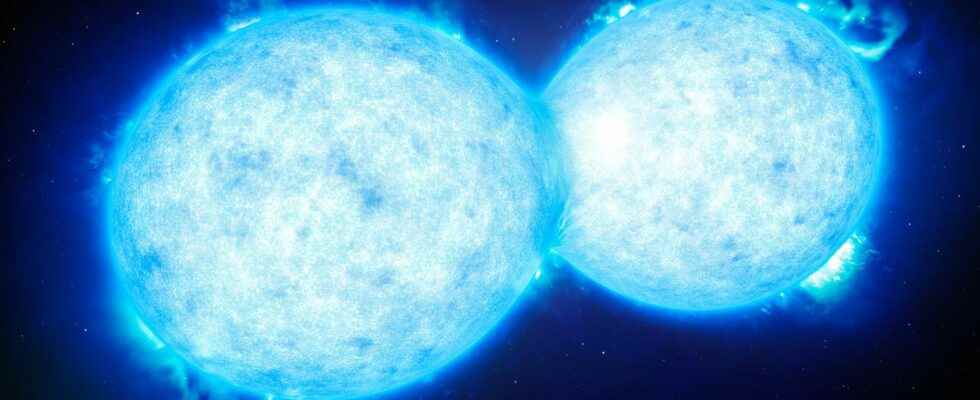The first candidates for the title of black hole, that is to say objects so compact that they form a closed region of thespace-time behaving like a membrane that can only be crossed in one direction, from the outside to the inside, because to escape this bubble it would be necessary to be able to go beyond the speed of lightwere by their emissions of X-rays.
Indeed, in this case, thestar compact is part of a binary system with a star from which flows gas pulled by tidal forces from the black hole. Gas spiraling toward the black hole forms an accretion disk with viscous friction forces between the rings of the disk releasing so much heat that the matter becomes a hot and ionized plasma, capable of emitting streams of X-rays.
We can estimate the masses death black holes part of stars binaries X, as they are called, and they are mostly between 5 and 15 solar masses. This is fairly consistent with the training scenarios and models of stellar black holes on the occasion of thecollapse gravity of a star of at least 30 solar masses approximately which explodes at this moment in supernovae SNII.
Great was therefore the surprise when the first direct detection on Earth of the gravitational wave of the merger of black holes in a binary system, in 2015, showed that the black holes before the collision each had a mass of about 30 solar masses. After the source case GW150914the source case GW190521 on May 21, 2019 turned out to be even more astonishing since the analyzes of the signal detected with Ligo and Virgo showed that a merger had occurred between two black holes of about 85 and 66 solar masses respectively, producing a new black hole of about 140 solar masses (the missing masses left as energy in the gravitational radiation of the merger).
Jean-Pierre Luminet, research director at the CNRS and Françoise Combes, professor at the Collège de France, tell us about black holes. © Hugot Foundation of the College de France
The astrophysicists Relativists have therefore sought explanations for the existence of these black holes and several possible scenarios, by no means exclusive, have begun to be worked out. One of them was the subject of skilful simulations on computer by the Demoblack collaboration team (acronym for ” The demography of black hole binaries in the era of gravitational wave astronomy “, that is to say The demography of black hole binaries in the age of gravitational wave astronomy) from the University of Padua in Italy.
Led by the astrophysicist Michela Mapellithe results obtained by the group’s researchers were recently presented at a meeting of theAmerican Physical Society.
Here is the scenario explored.
Collisions and captures of stars in open clusters
In general, in a galaxy as the Milky Waythe self-gravitating fluid density ofstars is so low that a description by the kinetic theory of gases with the famous Boltzmann equation, which describes their behavior, does not involve a collision term. Clearly, the stars have almost no chance of colliding.
But it is not the same in the open clusters young stars which are formed by the collapse of a large cloud molecular cold. Admittedly, these clusters are not really bound by their own gravity and the tidal forces exerted by the matter of the discs in which they are located will dissociate them in a few tens of millions of years at most in general. But this is enough for pairs of stars to form with collisions.
Young massive stars burning their fuel before exploding into supernovae in a few million years are formed in these open clusters and it is therefore possible to have collisions followed by fusion. The work of Michela Mapelli and his colleagues concerned mergers of these stars with masses of 40-60 solar masses for the first time in these open clusters and they show that indeed stellar black holes of several tens of solar masses can appear .
Above all, again because the clusters remain dense long enough, pairs of these massive black holes can form and collide losing energy in the form ofgravitational waveswhich causes the distances between the components of the pairs to decrease, thus giving an even more massive black hole which in turn…
Michela Mapelli explains the problem of the formation of binary black holes detected with gravitational waves. To obtain a fairly accurate French translation, click on the white rectangle at the bottom right. The English subtitles should then appear. Then click on the nut to the right of the rectangle, then on “Subtitles” and finally on “Translate automatically”. Choose “French”. © Institute for Pure & Applied Mathematics (IPAM)
This scenario of hierarchical growth therefore appears to be possible. According to Mapelli, these stellar collisions can create ultimately binary black holes with a mass greater than 40 suns. Repeated collisions and mergers could then produce black holes of much higher mass, ranging from about 100 to 10,000 times the mass of the sun.
” We are not sure that these collisions are the only possible explanation for an event like GW190521. These simulations do not reject others “, However, specifies Michela Mapelli.
Indeed, it has for example been proposed that this type of binary black hole is a product of the mutual capture of members of a large population of primordial black holes formed during the big Bang and which could account for the nature of the black matter.
Interested in what you just read?
